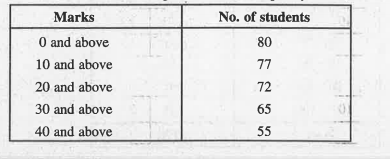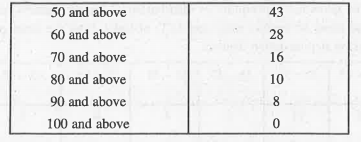Let u(x)andv(x)
be differentiable functions such that
u(x)v(x)=7 If u′(x)v′(x)=pand(u(x)v(x))′=q,thenp+qp−q
has the value
(a)
1 (b) 0
(c) 7 (d)
−7Solution in Punjabi
The correct Answer is:1
Step by step video & image solution for Let u(x) and v(x) be differentiable functions such that (u(x))/(v(x))=7 If (u^(prime)(x))/(v^(prime)(x))=p and ((u(x))/(v(x)))^'=q ,then (p+q)/(p-q) has the value (a) 1 (b) 0 (c) 7 (d) -7 by Maths experts to help you in doubts & scoring excellent marks in Class 12 exams.
Updated on:21/07/2023Topper's Solved these Questions
- INDEFINITE INTEGRAL BOOK - ARIHANT MATHSCHAPTER - INDEFINITE INTEGRAL EXERCISE - Exercise (Subjective Type Questions)
15 Videos
- INDEFINITE INTEGRAL BOOK - ARIHANT MATHSCHAPTER - INDEFINITE INTEGRAL EXERCISE - Exercise (Questions Asked In Previous 13 Years Exam)
8 Videos
- INDEFINITE INTEGRAL BOOK - ARIHANT MATHSCHAPTER - INDEFINITE INTEGRAL EXERCISE - Exercise 5 ( Matching Type Questions )
2 Videos
- HYPERBOLABOOK - ARIHANT MATHSCHAPTER - HYPERBOLAEXERCISE - Hyperbola Exercise 11 : Questions Asked in Previous 13 Years Exams
3 Videos
- INVERSE TRIGONOMETRIC FUNCTIONSBOOK - ARIHANT MATHSCHAPTER - INVERSE TRIGONOMETRIC FUNCTIONSEXERCISE - Exercise (Questions Asked In Previous 13 Years Exam)
8 Videos
Similar Questions
The value of
∫e(xsinx+cosx).(x4cos3x−xsinx+cosxx2cos2x)dx, is equal to
View SolutionThe integral ∫sec2x(secx+tanx)92dx equals (for some arbitrary constant K).
View SolutionFind the mean marks of the following cummulative frequency table :


View Solutionwhich term of the following sequence : 312,3,332.....is 81?
View SolutionIf α=3sin−1(611andβ=3cos−1(49), where the inverse trigonometric functions take only the principal values, then the correct options (s) is (are)
View SolutionLet u(x)andv(x) be differentiable functions such that u(x)v(x)=7. If (u'(x))/(v'(x))=p and ((u'(x))/(v'(x)))=q,then(p+q)/(p-q)hasthevalueof→(a) 1 (b) 0 (c) 7 (d) −7
View SolutionLet u(x) and v(x) are differentiable functions such that u(x)v(x)=7 . If u'(x)v'(x)=p and (u(x)v(x))′=q , then p+qp−q has the value equal to 1 (b) 0 (c) 7 (d) −7
View SolutionLet u(x) and v(x) be differentiable functions such that
u(x)v(x)=7.ifu'(x)v'(x)=pand(u(x)v(x))'=q, then p+qp−q has the value equal to
View SolutionConsider the following relations from A to B where
A={u, v, w, x, y, z} and B={p, q, r, s}.
1. {(u,p),(v,p),(w,p),(x,q),(y,q),(z,q)}
2. {(u,p),(v,q),(w,r),(z,s)}
3. {(u,s),(v,r),(w,q),(u,p),(v,p),(z,q)}
4. {(u,q),(v,p),(w,s),(x,r),(y,q),(z,s)}
Which of the above relations are not functions ?
View SolutionLet U (x) and V(x) be two differentiable function. Given U(x)V(x)=7, if U'(x)V'(x)=p and [U(x)V(x)]=q then the value of p+qp−q is_
View SolutionLet u(x) and v(x) be differentiable functions such that u(x):v(x)=7.
If : u'(x):v'(x)=p and y'(2)=7, then: (p+q):(p−q)=
View SolutionProve that ∣∣ ∣ ∣∣a+bxc+dxp+qxax+bcx+dpx+quvw∣∣ ∣ ∣∣=(1−x3)∣∣ ∣ ∣∣acpbdquvw∣∣ ∣ ∣∣
View SolutionLet u(x)andv(x) be differentiable functions such that u(x)v(x)=7. If (u'(x))/(v'(x))=p and ((u'(x))/(v'(x)))=q,then(p+q)/(p-q)hasthevalueof→(a) 1 (b) 0 (c) 7 (d) −7
View SolutionLet u(x)andv(x) be differentiable functions such that u(x)v(x)=7.u′(x)v′(x)=pand(u(x)v(x))'=q,thenp+qp−q has the value of to 1 (b) 0 (c) 7 (d) −7
View SolutionWithout expanding, prove that ∣∣ ∣ ∣∣a+bxc+dxp+qxax+bcx+dpx+quvw∣∣ ∣ ∣∣=(1−x2)∣∣ ∣ ∣∣acpbdquvw∣∣ ∣ ∣∣ .
View SolutionIf f(x)=log{u(x)v(x)}, u(1)=v(1) and u′(1)=v′(1)=2 , then find the value of f′(1) .
View Solution
